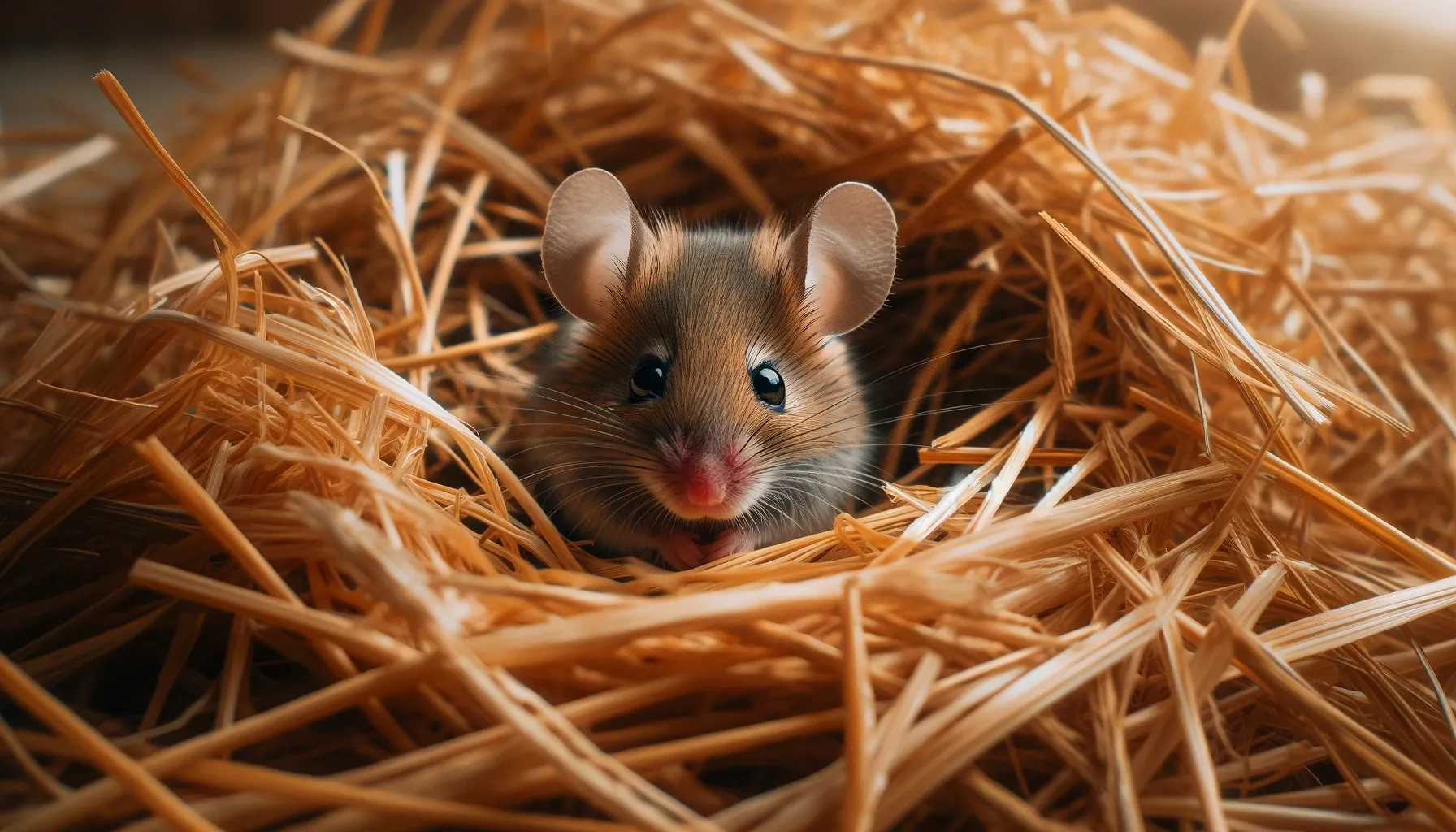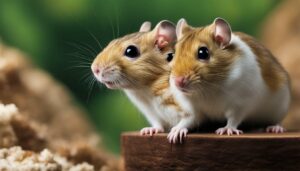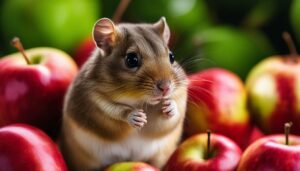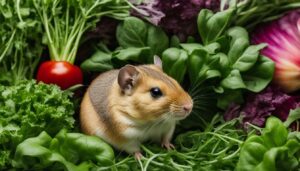If you’ve ever wondered if mice have an affinity for hay, you’re not alone. Many mouse owners and enthusiasts are curious about whether these small creatures enjoy hay as part of their diet or as bedding material.
In this article, we’ll explore the relationship between mice and hay, providing insights to help you better understand their preferences and needs.
Key Takeaways:
- Mice do like hay and may chew on it or use it for nesting material.
- It is important to watch out for mites that may be present in hay.
- Freezing or baking the hay can help reduce the risk of mites.
- Mice are attracted to a variety of foods, including fruits, berries, nuts, plants, grains, seeds, meat, garbage scraps, and pet food.
- Victor offers various solutions for getting rid of mice quickly, such as scent repellents, live traps, hygienic traps, electronic traps, and ultrasonic repellents.
Understanding Mice Diets and Habits
Before we dive into whether mice like hay, let’s first gain an understanding of their diets and habits. Mice are opportunistic feeders, meaning they will eat a wide variety of foods depending on what is available.
Their natural diet consists of seeds, grains, plants, and insects, but they are also attracted to fruits, berries, nuts, meat, garbage scraps, and even pet food.
When it comes to hay, mice have shown a preference for it as both a dietary option and as nesting material.
They will chew on hay and sometimes use it to construct their nests. This behavior is instinctual and helps them create a comfortable and safe environment for breeding and raising their young.
However, it’s important to be cautious when using hay as bedding for mice. Hay can sometimes contain mites, which can infest the mice and cause health issues.
To reduce the risk of mite infestation, it is recommended to freeze or bake the hay before using it. This process helps kill any potential mites and ensures a hygienic environment for your pet mice.
| Mice Diets | Mice Habits |
|---|---|
|
|
Hay as a Bedding Option for Mice
Apart from being a potential food source, hay is also considered as a preferred bedding option for mice. It provides them with a soft and cozy material to burrow into, mimicking their natural habitat.
Studies have shown that mice show a preference for hay when given a choice of bedding materials.
When selecting hay for bedding, it is important to ensure its cleanliness and quality. Mites can be a concern when using hay, as these tiny pests can infest the bedding and cause discomfort to the mice.
To prevent mite infestation, it is recommended to freeze or bake the hay before using it as bedding. This process helps eliminate any mites or eggs that may be present, providing a hygienic environment for your mice.
Mice are known for their curious and exploratory nature, and they enjoy chewing on various materials, including hay.
Chewing on hay not only helps keep their teeth trimmed but also provides mental stimulation. However, it is essential to monitor their chewing behavior to prevent any potential health risks.
If excessive chewing leads to digestive issues or blockages, it may be necessary to limit their access to hay.
Table: Hay Preference Study in Mice
| Bedding Material | Preference Level |
|---|---|
| Hay | High |
| Shredded Paper | Medium |
| Wood Shavings | Low |
In a study conducted on mice’s bedding preferences, hay emerged as a top choice. The mice demonstrated a high level of preference for hay compared to other commonly used bedding materials such as shredded paper or wood shavings.
This finding further supports the notion that mice indeed appreciate and enjoy the presence of hay in their habitat.
In conclusion, hay serves as an excellent bedding option for mice, providing them with both comfort and stimulation.
However, it is crucial to take precautions against mites and monitor their chewing behavior. By ensuring cleanliness and quality, hay can enhance the living environment of your pet mice, allowing them to thrive and feel at home.
The Importance of Choosing the Right Bedding
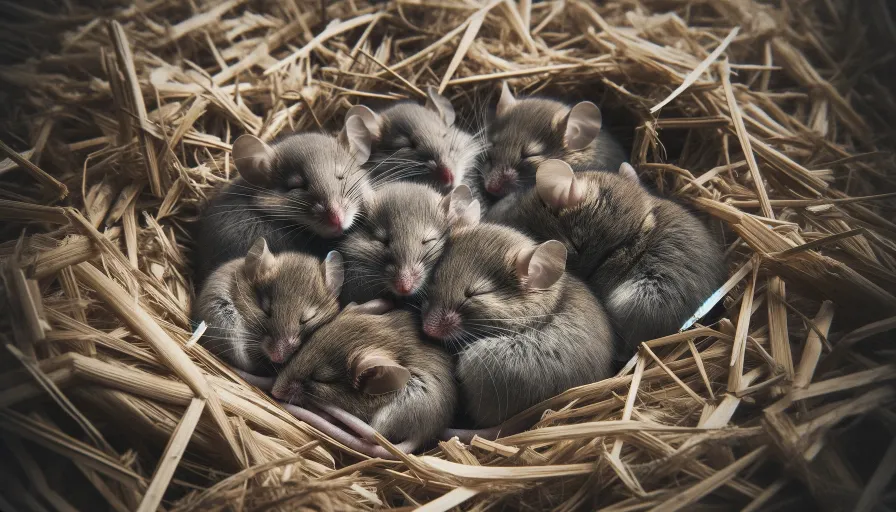
Choosing the right bedding for your pet mice is crucial for their overall health and happiness. Mice spend a significant amount of time in their bedding, so it is important to provide them with a comfortable and safe environment.
When selecting bedding, consider the following factors to ensure you make the best choice for your furry friends.
1. Absorbency: Mice produce a lot of urine, so it is important to choose bedding that is highly absorbent. Materials like paper-based bedding or aspen shavings are known for their absorbency and can help keep your mice dry and comfortable.
2. Dust-Free: Mice have sensitive respiratory systems, so it is essential to opt for dust-free bedding. Avoid using cedar or pine shavings, as they can release harmful oils and strong odors that may irritate your mice’s respiratory system. Instead, consider using paper-based or recycled bedding.
3. Odor Control: Mice have a natural musky odor, but the right bedding can help control and minimize any unpleasant smells. Look for bedding that has odor-control properties or is made from materials like activated carbon, which can help absorb odors.
| Bedding Option | Absorbency | Dust-Free | Odor Control |
|---|---|---|---|
| Paper-based bedding | High | Yes | Yes |
| Aspen shavings | High | Yes | No |
| Cedar shavings | Moderate | No | No |
| Pine shavings | Moderate | No | No |
Remember to regularly clean your mice’s bedding to maintain a hygienic environment. This will help prevent any potential health issues and keep your mice happy and comfortable.
By choosing the right bedding, you are ensuring that your pet mice have a cozy and safe place to rest and play.
Mites and Hay
While hay can serve as a suitable bedding option for mice, it’s essential to be aware of the potential presence of mites.
Mites can pose a risk to the health and well-being of your furry friends, so precautionary measures are necessary to maintain a clean and hygienic environment for them.
One effective way to address the issue of mites in hay is by freezing or baking it before use. Freezing the hay for at least 48 hours at a temperature below -4°F (-20°C) can help kill any mites or eggs present.
Alternatively, baking the hay at 250°F (121°C) for 30 minutes can also eliminate mites.
Regular cleaning and maintenance of the mouse habitat are crucial to prevent mite infestation. Remove and replace the hay bedding regularly, ensuring that it is kept dry and free from moisture, as mites thrive in damp conditions.
Regularly inspect your mice for any signs of mite infestation, such as excessive scratching, hair loss, or skin irritations.
If mites are detected, consult with a veterinarian for proper treatment.
| Mites and Hay Prevention Tips | Mites and Hay Treatment |
|---|---|
|
|
By taking these precautions and being diligent in monitoring your mice’s environment, you can ensure that hay remains a safe and suitable bedding option for them.
Enjoy watching your adorable companions make cozy nests and enjoy their chewy affair with hay!
Attracting Mice: A Gourmet Feast

Mice are not picky eaters and are attracted to a wide range of foods, which also influences their bedding preferences.
These small creatures have a natural inclination towards a variety of food items, ranging from fruits and berries to nuts and grains.
They are even known to indulge in meat, garbage scraps, and pet food. This diverse palate extends to their bedding choices as well.
When it comes to selecting bedding material, mice tend to gravitate towards options that align with their foraging habits.
They prefer materials that mimic their natural environment and provide both comfort and mental stimulation. This is where hay often comes into play.
Hay, with its earthy scent and textured strands, can attract mice due to its resemblance to natural nesting material.
Mice are known to chew on hay and use it to construct their nests, creating cozy spaces for themselves and their offspring.
However, it’s important to be cautious when using hay as bedding, as it can harbor mites.
Mites and Hay
Mites can be a concern when using hay as bedding for mice. These tiny parasites can cause irritation and discomfort for the rodents.
To minimize the risk of mite infestation, it is recommended to freeze or bake the hay before introducing it to their habitat.
This process helps eliminate any potential mites and creates a more hygienic environment for the mice.
| Pros of Hay as Mouse Bedding | Cons of Hay as Mouse Bedding |
|---|---|
| Resembles natural nesting material | Potential risk of mite infestation |
| Provides comfort and mental stimulation | May not be suitable for mice with allergies |
| Readily available and affordable | Difficult to clean and maintain freshness |
While hay can be a suitable bedding option for mice, it’s essential to monitor their behavior and ensure their well-being.
Regular cleaning and proper maintenance of their habitat, along with providing a balanced diet, will contribute to their overall health and happiness.
Mice and Hay: A Chewy Affair

When it comes to hay, mice have a curious behavior of chewing on it, but what does it mean? Let’s delve into their fascinating behavior and explore the reasons behind this chewy affair.
Chewing on hay is a natural instinct for mice. It serves multiple purposes in their lives. Firstly, it helps to keep their teeth healthy and worn down.
Mice have constantly growing teeth, and chewing on hay helps to prevent overgrowth and dental problems.
Secondly, mice enjoy the texture and taste of hay. It provides them with mental stimulation and enriches their environment.
Moreover, hay has practical uses for mice. They may use chewed hay to create cozy nests for resting and nesting material for their young.
It is important to ensure that the hay you provide for your mice is clean and free from pesticides or mites.
Freezing or baking the hay before use can help eliminate any potential mites and reduce the risk of infestation.
| Mouse Behavior with Hay | Meaning |
|---|---|
| Mice chew on hay | Maintains healthy teeth and prevents overgrowth |
| Mice use chewed hay for nesting | Creates cozy nests for resting and nesting material for young |
| Mice find hay texture and taste enjoyable | Provides mental stimulation and enriches their environment |
While hay is a favored material for mice, it is not the only option for bedding. Mice also appreciate the use of other soft materials such as shredded paper, straw, or aspen bedding.
It’s essential to choose a bedding option that is safe and comfortable for your furry friends. Pay attention to your mice’s preferences, and ensure the bedding promotes their well-being.
Enhancing Mice Habitat with Hay
Incorporating hay into the habitat of your pet mice can provide them with a more enriching experience.
Not only does it serve as a cozy bedding option, but it also offers opportunities for natural behaviors such as burrowing and nesting.
Hay mimics the natural environment of mice, allowing them to engage in their instinctual behaviors.
When using hay as bedding, it is important to ensure that it is of good quality and free from mites or pests.
Mites can be a common issue in hay, so taking precautions to prevent infestation is crucial. Freezing or baking the hay before use can help eliminate any potential mites, ensuring a hygienic environment for your pet mice.
Mice are known to chew on hay, which can provide dental stimulation and help maintain proper dental health.
It is essential to monitor the amount of hay provided to prevent overconsumption and potential blockages. Including other enrichment items such as tunnels, toys, and hiding spots can further enhance the mice’s habitat and provide them with mental stimulation.
| Benefits of Hay in Mice Habitat | Considerations |
|---|---|
|
|
Remember that each mouse is unique, and their preferences may vary. It’s always important to observe your pet mice and adjust their habitat accordingly.
Providing a safe and enriching environment with hay as a bedding option can contribute to the overall well-being and happiness of your furry friends.
Alternatives to Hay as Bedding
If hay isn’t the right fit for your mice, there are alternative bedding options that might better suit their needs.
While hay is a commonly used bedding material, it may not be suitable for all mice, especially those with specific allergies or sensitivities.
Here are a few alternatives you can consider:
Shredded Paper:
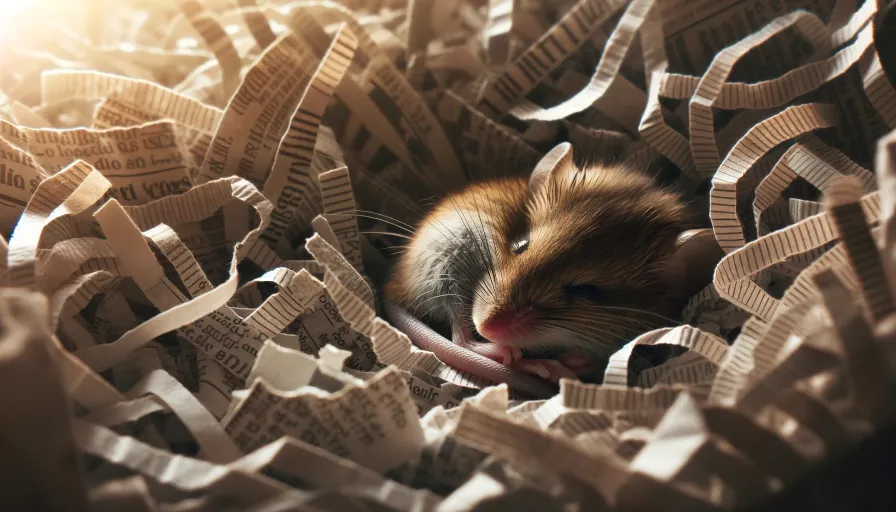
One popular option is shredded paper. You can use plain white paper or even newspaper as bedding for your mice.
Make sure to avoid using glossy or ink-covered paper as these may contain harmful chemicals. Shredded paper provides a soft and comfortable surface for your mice to burrow and nest in.
Just ensure that the paper is changed regularly to maintain cleanliness and prevent odor buildup.
Aspen Shavings:
Another viable alternative is aspen shavings. These are a safe and natural option that is free of aromatic oils, making it suitable for mice with respiratory sensitivities.
Aspen shavings are absorbent, helping to control odor, and they provide a cozy environment for your mice.
However, avoid using cedar or pine shavings as they can release harmful oils and chemicals that may affect your pets’ respiratory health.
Pellet Bedding:
Pellet bedding made from recycled paper or wood can also be a suitable option for mice. These pellets are highly absorbent and have excellent odor control, making them ideal for keeping your mice’s living space fresh and clean.
Pellet bedding is low-dust, which is beneficial for mice with respiratory issues. Make sure to choose pellets specifically designed for small animals like mice.
Remember, mice have different preferences, so it’s important to observe their behavior and adjust the bedding accordingly.
Regular cleaning and maintaining a hygienic living environment are crucial for your mice’s health and well-being.
By providing them with a comfortable and safe bedding material, you can ensure they have a cozy place to rest and play.
| Bedding Option | Advantages | Considerations |
|---|---|---|
| Shredded Paper | Soft and comfortable, readily available | Regular changes needed for cleanliness |
| Aspen Shavings | Natural and safe, good odor control | Avoid cedar or pine shavings |
| Pellet Bedding | Highly absorbent, excellent odor control | Choose small animal-specific pellets |
Conclusion
After examining the dietary preferences and behaviors of mice, as well as their interaction with hay, it can be concluded that mice do have a preference for hay, albeit with certain considerations.
Mice are naturally attracted to hay and will often chew on it, using it for nesting material. This behavior is a reflection of their natural instincts and can provide them with mental stimulation.
However, it is important to be cautious when using hay as bedding for mice.
One concern when using hay as bedding is the potential presence of mites. These tiny pests can infest the hay and affect the health of your mice.
To minimize the risk, it is recommended to freeze or bake the hay before using it. This process helps eliminate any mites that may be present, ensuring a hygienic environment for your furry friends.
It is also worth noting that while mice have a preference for hay, they are attracted to a variety of other foods as well.
Their diet includes fruits, berries, nuts, plants, grains, seeds, meat, garbage scraps, and even pet food. Therefore, it is important to provide a balanced diet to keep your mice healthy and satisfied.
Overall, hay can be a suitable bedding option for mice, but it should be used with care. By taking necessary precautions to prevent mite infestation and providing a well-balanced diet, you can create a comfortable and enriching habitat for your pet mice.
FAQ
Do mice like hay?
Yes, mice do like hay and they will chew on it and sometimes use it for nesting material.
Are there any risks associated with using hay for mice?
It is important to watch out for mites that may be present in hay. Freezing or baking the hay can help reduce the risk of mites.
What other foods attract mice?
Mice are attracted to a variety of foods including fruits, berries, nuts, plants, grains, seeds, meat, garbage scraps, and pet food.
What solutions does Victor offer for getting rid of mice quickly?
Victor offers various solutions for getting rid of mice quickly, such as scent repellents, live traps, hygienic traps, electronic traps, and ultrasonic repellents.

